Peugeot 406 C 2003 Manual PDF
Manufacturer: PEUGEOT, Model Year: 2003, Model line: 406 C, Model: Peugeot 406 C 2003Pages: 141, PDF Size: 1.99 MB
Page 71 of 141

24-03-2003
4 - Setting the air distribution
Successive presses on the top or bottom part of thisbutton allow the air to bedirected to:
- the windscreen (de-icing or demist-ing),
- the windscreen and footwells,
- the central and side vents,
- the central and side vents andfootwells,
- the footwells.
Press the top or bottom part of thebutton to select the previous or nextsetting from the above list. Manual operation Y
ou may, if you wish, make a differ-
ent choice from that offered by the system, by changing one of the set-tings. Press the " AUTO" button to return to
automatic operation.
5 - Air conditioning
Pressing this button stops the air condi-
tioning. Pressing again returns theair conditioning to automatic opera-
tion. The symbol " A/C" is displayed.
6 - Air flow
The air flow may beincreased or reducedby pressing the '' + ''
or '' –'' button respectively. 7 - Air intake
This button ispressed for recircula-
tion of the interior air.
Recirculation, shown on the display,prevents the entry of unpleasantodours or fumes into the passengercompartment from outside. A void prolonged operation of the
recirculation of interior air. A second press returns the system to automat-
ic intake of air. Used in humid conditions, recircula- tion risks misting up the windows.
8 - Demisting therear screen
With the engine run-ning, pressing the
switch demists the rear screen andthe mirrors.
It switches off automatically after approximately fifteen minutes. Press again to resume demisting. It is possible to stop the demisting
operation before it goes off automat-
ically, by pressing the switch again. Note: The condensation created by
air conditioning causes a normal flow of water under the vehicle when
stationary.
YOUR 406 COUPE IN DETAIL 51
Page 72 of 141

YOUR 406 COUPE IN DETAIL
92
24-03-2003
Page 73 of 141
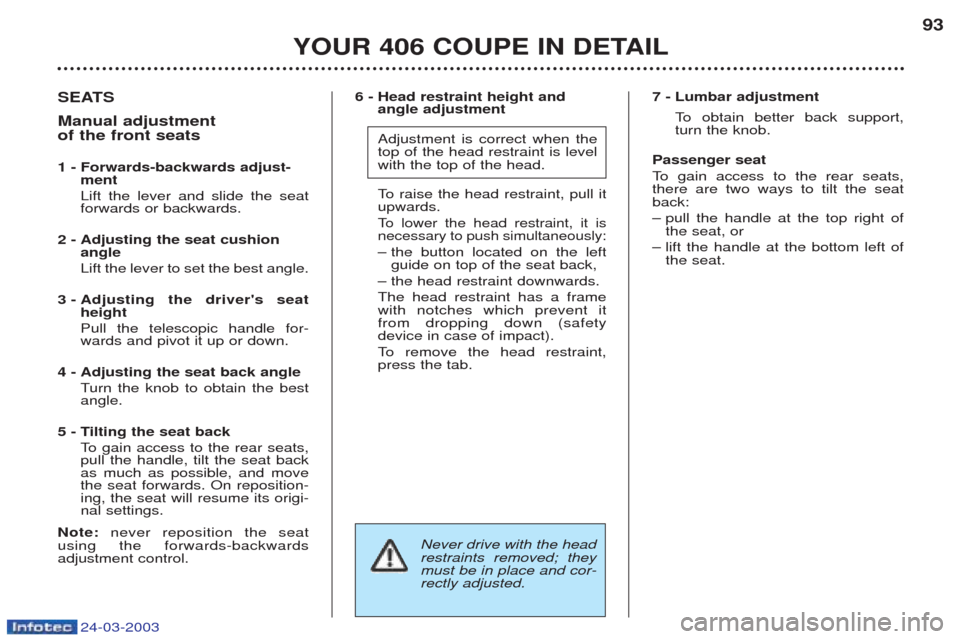
24-03-2003
6 - Head restraint height andangle adjustment Adjustment is correct when the top of the head restraint is levelwith the top of the head.
To raise the head restraint, pull it
upwards.
To lower the head restraint, it is
necessary to push simultaneously:
Ð the button located on the left guide on top of the seat back,
Ð the head restraint downwards. The head restraint has a frame with notches which prevent itfrom dropping down (safetydevice in case of impact).
To remove the head restraint,
press the tab. 7 - Lumbar adjustment
To obtain better back support,
turn the knob.
Passenger seat
To gain access to the rear seats,
there are two ways to tilt the seat back:
Ð pull the handle at the top right of the seat, or
Ð lift the handle at the bottom left of the seat.
93
YOUR 406 COUPE IN DETAIL
SEATS Manual adjustment of the front seats
1 - Forwards-backwards adjust- ment Lift the lever and slide the seat forwards or backwards.
2 - Adjusting the seat cushion angle Lift the lever to set the best angle.
3 - Adjusting the driver's seat height Pull the telescopic handle for- wards and pivot it up or down.
4 - Adjusting the seat back angle Turn the knob to obtain the best
angle.
5 - Tilting the seat back To gain access to the rear seats,
pull the handle, tilt the seat backas much as possible, and movethe seat forwards. On reposition-ing, the seat will resume its origi-nal settings.
Note: never reposition the seat
using the forwards-backwards adjustment control.
Never drive with the head restraints removed; theymust be in place and cor-rectly adjusted.
Page 74 of 141
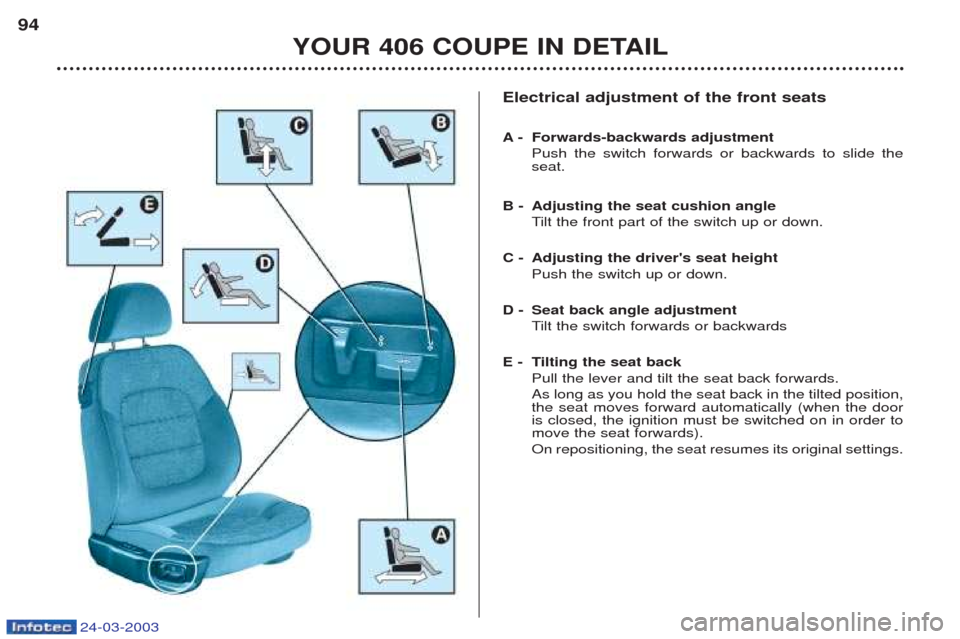
Electrical adjustment of the front seats
A- Forwards-backwards adjustment Push the switch forwards or backwards to slide the seat.
B - Adjusting the seat cushion angle Tilt the front part of the switch up or down.
C - Adjusting the driver's seat height Push the switch up or down.
D - Seat back angle adjustment Tilt the switch forwards or backwards
E - Tilting the seat back Pull the lever and tilt the seat back forwards. As long as you hold the seat back in the tilted position, the seat moves forward automatically (when the dooris closed, the ignition must be switched on in order tomove the seat forwards). On repositioning, the seat resumes its original settings.
YOUR 406 COUPE IN DETAIL
94
24-03-2003
Page 75 of 141

24-03-2003
Recalling a memorised position
Page 76 of 141

24-03-2003
REAR SEATS Rear seat with fold-down backs Before carrying out any operation, in order to prevent damage to theseat belts, place them in the loca-tions provided. The rear seat back folds down in two sections.To
fold down the seat back
The release controls are situated inthe boot. Pull the control corresponding to the part of the seat back that you wish tofold down. When returning the seat back to its original position, ensure that it islocked correctly to guarantee your
safety.
YOUR 406 COUPE IN DETAIL
96
Ski flap Lower the arm rest to access the ski flap.
Page 77 of 141
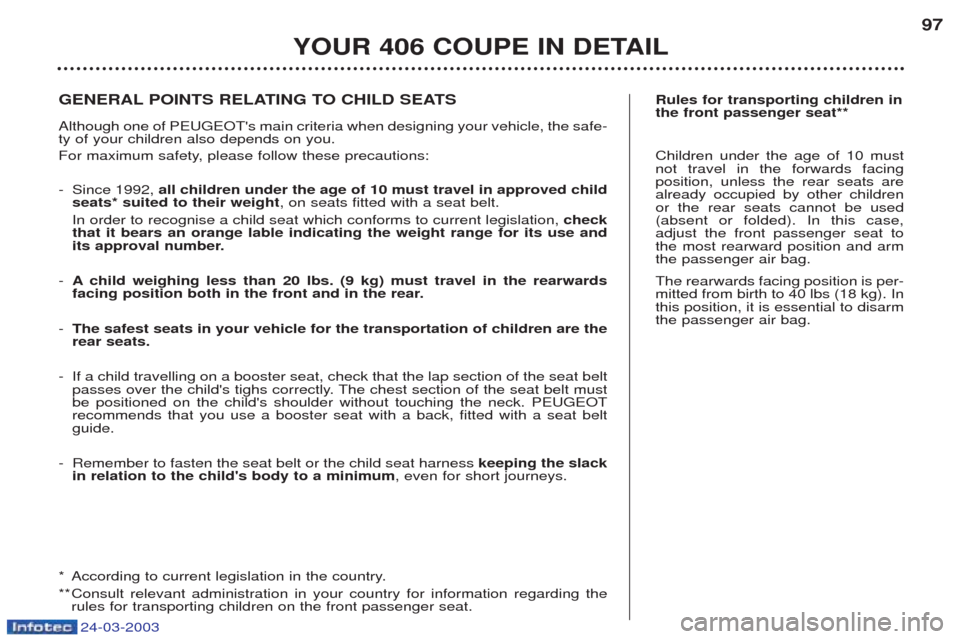
24-03-2003
YOUR 406 COUPE IN DETAIL97
Rules for transporting children in the front passenger seat** Children under the age of 10 must not travel in the forwards facingposition, unless the rear seats arealready occupied by other childrenor the rear seats cannot be used(absent or folded). In this case,adjust the front passenger seat tothe most rearward position and armthe passenger air bag. The rearwards facing position is per- mitted from birth to 40 lbs (18 kg). Inthis position, it is essential to disarmthe passenger air bag.
GENERAL POINTS RELATING TO CHILD SEATS Although one of PEUGEOT's main criteria when designing your vehicle, the safe- ty of your children also depends on you.
For maximum safety, please follow these precautions: - Since 1992, all children under the age of 10 must travel in approved child
seats* suited to their weight , on seats fitted with a seat belt.
In order to recognise a child seat which conforms to current legislation, check
that it bears an orange lable indicating the weight range for its use and
its approval number.
- A child weighing less than 20 lbs. (9 kg) must travel in the rearwards
facing position both in the front and in the rear.
- The safest seats in your vehicle for the transportation of children are therear seats.
- If a child travelling on a booster seat, check that the lap section of the seat belt
passes over the child's tighs correctly. The chest section of the seat belt mustbe positioned on the child's shoulder without touching the neck. PEUGEOTrecommends that you use a booster seat with a back, fitted with a seat beltguide.
- Remember to fasten the seat belt or the child seat harness keeping the slack
in relation to the child's body to a minimum , even for short journeys.
* According to current legislation in the country.
** Consult relevant administration in your country for information regarding the rules for transporting children on the front passenger seat.
Page 78 of 141
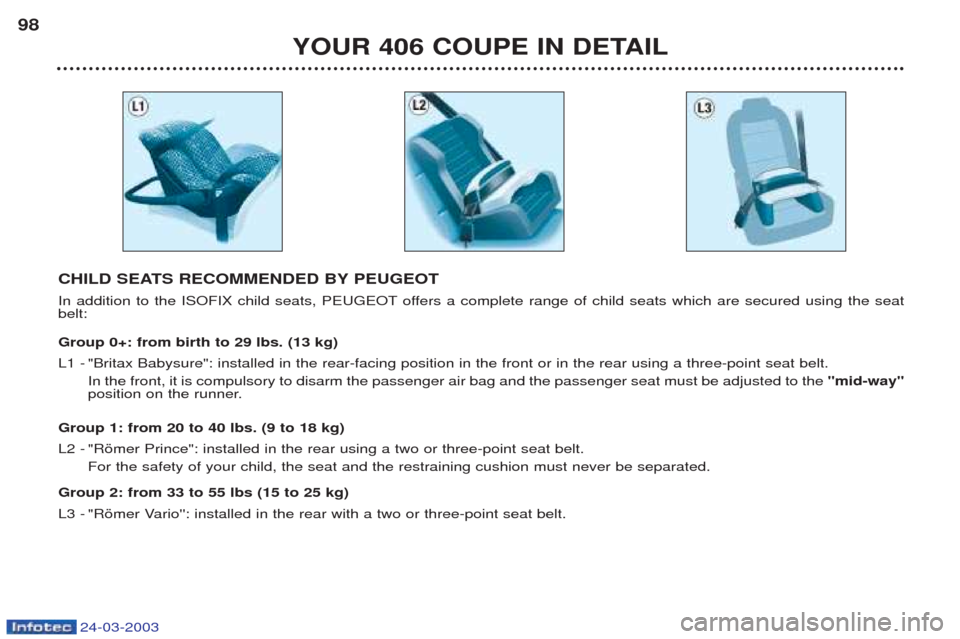
24-03-2003
YOUR 406 COUPE IN DETAIL
98
CHILD SEATS RECOMMENDED BY PEUGEOT
In addition to the ISOFIX child seats, PEUGEOT offers a complete range of child seats which are secured using the seat belt: Group 0+: from birth to 29 lbs. (13 kg)
L1 - "Britax Babysure": installed in the rear-facing position in the front or in the rear using a three-point seat belt.
In the front, it is compulsory to disarm the passenger air bag and the passenger seat must be adjusted to the "mid-way"
position on the runner.
Group 1: from 20 to 40 lbs. (9 to 18 kg)
L2 - "Ršmer Prince": installed in the rear using a two or three-point seat belt. For the safety of your child, the seat and the restraining cushion must never be separated.
Group 2: from 33 to 55 lbs (15 to 25 kg)
L3 - "Ršmer Vario'': installed in the rear with a two or three-point seat belt.
Page 79 of 141
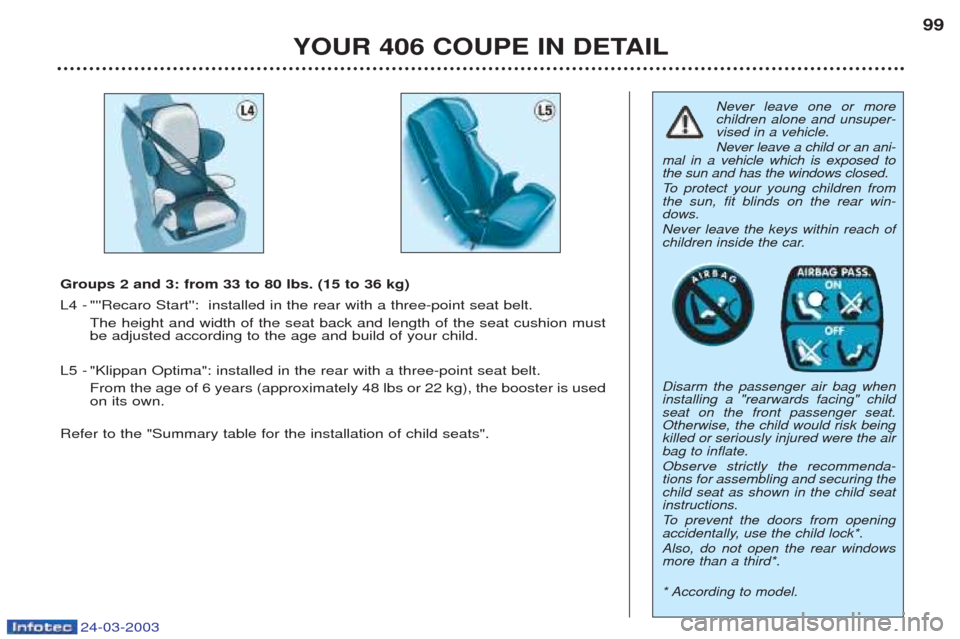
24-03-2003
Never leave one or more children alone and unsuper-vised in a vehicle. Never leave a child or an ani-
mal in a vehicle which is exposed to the sun and has the windows closed.
To protect your young children from
the sun, fit blinds on the rear win- dows. Never leave the keys within reach of
children inside the car. Disarm the passenger air bag when installing a "rearwards facing" childseat on the front passenger seat.Otherwise, the child would risk beingkilled or seriously injured were the airbag to inflate. Observe strictly the recommenda- tions for assembling and securing thechild seat as shown in the child seatinstructions.
To prevent the doors from opening
accidentally, use the child lock*.Also, do not open the rear windows more than a third*.
* According to model.
YOUR 406 COUPE IN DETAIL 99
Groups 2 and 3: from 33 to 80 lbs. (15 to 36 kg)
L4 - "''Recaro Start'': installed in the rear with a three-point seat belt.
The height and width of the seat back and length of the seat cushion must be adjusted according to the age and build of your child.
L5 - "Klippan Optima": installed in the rear with a three-point seat belt. From the age of 6 years (approximately 48 lbs or 22 kg), the booster is usedon its own.
Refer to the "Summary table for the installation of child seats".
Page 80 of 141

24-03-2003
YOUR 406 COUPE IN DETAIL
100
SUMMARY TABLE FOR THE INSTALLATION OF CHILD SEATS In accordance with European regulations (Directive 2000/3), the table below indicates the extent to which each seat in your vehicle may be fitted with a child seat:
U: universal category
According to destination:
L1 : BRITAX Babysure E11 0344117 Universal (birth to 29 lbs or 13 kg).
L2 : ROMER Prince E1 03301058 Universal (20 to 40 lbs or 9 to18 kg).
L3 : ROMER Vario E1 03301120 Universal (33 to 55 lbs or 15 to 25 kg)
L4 : RECARO Start E1 03301108 Universal (33 to 80 lbs or 15 to 36 kg).
L5 : KLIPPAN Optima E17 030007 Universal (33 to 80 lbs or 15 to 36 kg).
L6 : KIDDY Isofix Rearwards facing E1 03301123 and Universal (birth to 29 lbs or 13 kg).
L7 : KIDDY Isofix Forwards facing E2 030011 Universal (20 to 40 lbs or 9 to 18 kg). (a) Group 0: from birth to 8 lbs (10 kg).
(b) Consult the current legislation in your country.
Statutory weight range
Seat Group 0(a)
at 0+ Group 1 Group 2 Group 3
< 29 lbs (13 kg)
20 - 40 lbs (9 - 18 kg) 33 - 55 lbs (15 - 25 kg) 48 - 80 lbs (22 - 36 kg)
Front passenger seat(b)
with and without booster L1, L6 L2, L7 L3, L4, L5 L4, L5
Rear passenger seat UU UU
Side seat L1, L6 L2, L7 L3, L4
(recline position) L4 (recline position), L5